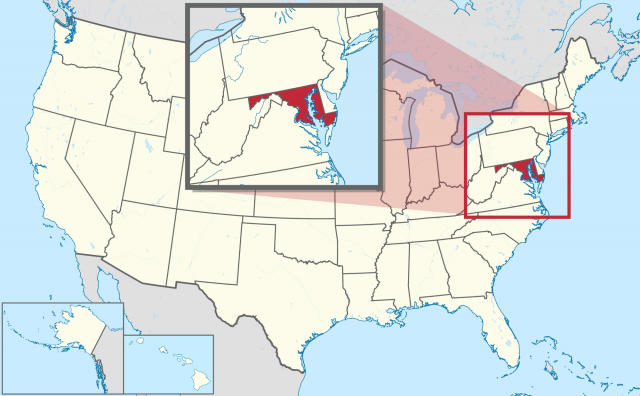Maryland
“THE OLD LINE STATE,” covering an area of 12,407 square mi (32,134 square km) is located in the mid-Atlantic UNITED STATES and features a diverse geography, prompting the nickname “a miniature America.” Maryland is one of the more irregularly shaped states, with a long straight northern border and an irregular southern border that is delineated by 285 mi (459 km) of the Potomac River. At its most narrow point, Maryland is only a scant few miles from its northern border to its southern border; at its widest point it is about 124 mi (200 km) from northern to southern border. Along the northern border, the state is bounded by PENNSYLVANIA for 190 mi (320 km), and on the western border is WEST VIRGINIA. On the south, Maryland is bordered by West Virginia at the far western reaches of the state and by VIRGINIA. Over the years, border disputes have occurred with Virginia, West Virginia, and Pennsylvania.
The nation's capital, Washington, D.C., is located between Virginia and Maryland about 39 mi (63 km) southwest of the largest city in Maryland, Baltimore. The easternmost portion of Maryland is split into two by the Chesapeake Bay. This part of the state shares what is known as the DELMARVA PENINSULA with DELAWARE to the east and Virginia to the south. The highest point in the state is Backbone Mountain, located in the western reaches, 3,360 ft (1,024 m) above sea level.

The easternmost section of the state is a coastal plain at or about sea level and has considerable wetlands and marshes, especially along the Chesapeake Bay. The central part of the state, known as the Piedmont Plateau, is more hilly, while the westernmost part of Maryland is mountainous, containing a part of the Allegheny Mountains. Farming was historically prevalent in the central part of the state, while coal mining was done in the mountains of the west. The Piedmont area is also known for its racehorse breeding. The southernmost area of Maryland has for hundreds of years been known for its tobacco farming, though this is now in serious decline. Forests are prevalent in western Maryland, with oak, pine and hickory trees. On the coastal plain, cypress and gum trees are common.
The chief city of western Maryland is Cumberland, and Hagerstown is the largest city in central Maryland. Baltimore, the most populous city in the state, is located on the Chesapeake Bay, while the capital, Annapolis, a much smaller city, is located 30 mi (48 km) south of Baltimore, also on the bay. The major tourist attractions are Baltimore, which has revitalized its historic waterfront. This city, the birthplace of Babe Ruth, has a notable maritime museum and is home to the USS Constitution, an 18th-century naval warship. On the Atlantic side of the DELMARVA PENINSULA, Ocean City is a popular vacation destination for beachgoers. The forested mountains of the west are a popular destination, and the historic town of Harpers Ferry, West Virginia, is just a couple of minutes from Maryland's border. The northern suburbs of Washington, D.C., are in Maryland, including the populous Silver Spring. Many of these neighborhoods are connected to the nation's capital by the subway system, known as the Washington Metro. Camp David, the presidential retreat, is also in Maryland.
Maryland's roots go back to the early 17th century, when Captain John Smith mapped the area in 1608. The king of England granted Cecil Calvert, the Lord of Baltimore, a land patent in 1632. The first ships bearing European settlers arrived in 1634. They founded what is now St. Mary's City on the bay. A border dispute between the colonies of Pennsylvania and Maryland resulted in two surveyors, Mason and Dixon, being called upon in the 1760s to chart the exact border. Their Mason-Dixon line has since been the unofficial line between north and south. Annapolis was the nation's capital for a few years beginning in 1783. Maryland was in the midst of events during the War of 1812, when the British laid siege upon Washington, D.C. Francis Scott Key wrote the poem that became the national anthem, “The Star Spangled Banner,” in 1814 while watching the British bombardment of Fort McHenry in Baltimore Harbor.
Development of the state continued to be rapid. The first railroad in the country was begun in Maryland in the 1820s. In the Civil War, Maryland sided with the north, but thousands of its citizens joined the Confederate Army, believing their tobacco plantations were at risk if slaves were freed. The bloody Battle of Antietam was fought in Maryland in 1862, resulting in more than 20,000 deaths. Nineteenth-century Baltimore was a major destination for immigrant ships from Europe.